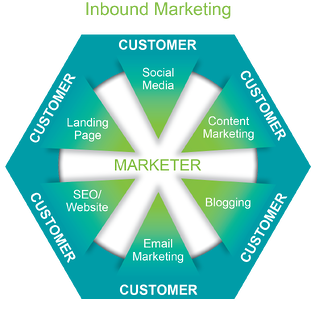The Age of the Self-Directed Buyer
The information age (a.k.a. digital age) has given us instant access to information. You just “Google it”. This has resulted in a fundamental shift in behavior. We have become self-directed buyers. We want more control over what information we receive and when. I can’t recall the last time I made a major purchase without spending time on-line researching my options, reading reviews and gathering information to guide my decision. Studies A recent study by Pardot shows that this is also the case with B2B customers. Almost three quarters (72%) of B2B buyers planning to purchase a business product begin their research with a Google search. In addition, after an initial search, 70% of buyers then return online 2-3 times to do additional research, and 12% return online more than three times.1

Marketing Channels Evolve
Traditional marketing uses tactics that buy attention such as traditional advertising (print, radio and television ads), direct mail, sales flyers, cold-calling and telemarketing. As new media are invented, marketers fill the channels. Print, radio, TV, and direct mail advertising went digital with banners, pop-ups and the dreaded SPAM. These intrusive interruptive marketing tactics have annoyed consumers. 86% of people skip television ads, 44% of direct mail is never opened, and we have even tried legislating it away (US passed CAN-SPAM Act of 2003 with similar regulations in Europe, Canada, Australia). These one-way communication tactics have been losing efficiency especially when used in a two-way medium like the internet.

Marketing Strategies Evolve
This shift has given rise to new marketing strategies that seek to engage customers in a dialogue by providing information in response to a customer’s query. This query, whether it comes as a direct question or in the form of an internet search, gives the marketer permission to provide information. Use of this as a marketing strategy is referred to as “Permission Marketing” or “Inbound Marketing”.
So, How Does Inbound Marketing Work?
An inbound marketing strategy focuses on creating content rich websites that help your customer find your company and product when they are actively involved in searching and seeking information. Typical inbound marketing tactics include using SEO, blogs, podcasts, video, eBooks, newsletters, whitepapers, and social media that serve to make the company easier to find, draw customers into their website and engage them with interesting content.
Is Traditional Marketing Dead?
Inbound marketing really is “something” but does this mean that outbound marketing is dead? Of course not! For most organizations a well-rounded marketing strategy includes a mix of inbound and traditional outbound tactics. Traditional marketing can help to bring awareness about a company’s brand, product or services to a wide audience that is not yet looking for those particular products and services. If you want to learn more on the subject check out our blog “Why it’s not Inbound Marketing vs Outbound Marketing”.
If you want to learn more about inbound marketing:
1) The State of Demand Generation 2013, Pardot, Based on data from a survey of 400 B2B buyers (53% employed by small businesses, 22% by mid-market companies, and 25% by enterprise companies). The majority (75%) of respondents were not marketers.
 Jacqueline Murray is a Marketing Strategist for DardenLentz, a B2B Marketing and Branding Agency focused on healthcare and technology. Jacqueline heads the firm's Ohio office, established to support the region's bioscience industry. She has held senior positions with global marketing responsibilities for both diagnostic and medical device companies.
Jacqueline Murray is a Marketing Strategist for DardenLentz, a B2B Marketing and Branding Agency focused on healthcare and technology. Jacqueline heads the firm's Ohio office, established to support the region's bioscience industry. She has held senior positions with global marketing responsibilities for both diagnostic and medical device companies.




